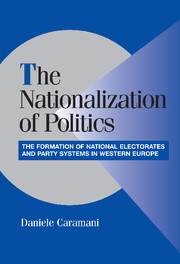 The Nationalization of Politics
The Nationalization of Politics Published online by Cambridge University Press: 02 December 2009
Historical Trends in Europe
Figures 3.1 to 3.4 display the general historical evolution of the levels of territorial homogeneity of party support and turnout (for all countries) from the 1830s to the present, as measured by different indicators weighting for the size of parties. They show the basic result of this broad exploration: a clear trend toward increasing nationally integrated electorates and homogeneous party systems over the past 150 years.
As mentioned earlier, figures of turnout and party support measure distinct aspects of the nationalization of politics:
Turnout: High territorial disparities in turnout indicate the survival of marginal areas in terms of socioeconomic development: economic structure – for example, the persistence of traditional society (an economically backward periphery) – literacy, certain forms of political culture (local clientelism or patronage), and so on; a pattern of homogeneous turnout rates, on the other hand, indicates how these marginal groups have been mobilized and integrated into the national political system.
Party support: This is an indicator of the strength of the territoriality of political cleavages that emerged from the National and Industrial Revolutions: center–periphery and cultural cleavages (ethnolinguistic and religious cleavages in particular) and socioeconomic cleavages such as the urban–rural cleavage and the left–right opposition between wage earners on the one hand and employers and owners on the other.
The shape of the curves in these figures toward a reduction of territorial disparities indicates therefore both the integration of electorates of peripheral regions and the reduction of the territoriality of political cleavages over the nineteenth and twentieth centuries.
To save this book to your Kindle, first ensure no-reply@cambridge.org is added to your Approved Personal Document E-mail List under your Personal Document Settings on the Manage Your Content and Devices page of your Amazon account. Then enter the ‘name’ part of your Kindle email address below. Find out more about saving to your Kindle.
Note you can select to save to either the @free.kindle.com or @kindle.com variations. ‘@free.kindle.com’ emails are free but can only be saved to your device when it is connected to wi-fi. ‘@kindle.com’ emails can be delivered even when you are not connected to wi-fi, but note that service fees apply.
Find out more about the Kindle Personal Document Service.
To save content items to your account, please confirm that you agree to abide by our usage policies. If this is the first time you use this feature, you will be asked to authorise Cambridge Core to connect with your account. Find out more about saving content to Dropbox.
To save content items to your account, please confirm that you agree to abide by our usage policies. If this is the first time you use this feature, you will be asked to authorise Cambridge Core to connect with your account. Find out more about saving content to Google Drive.